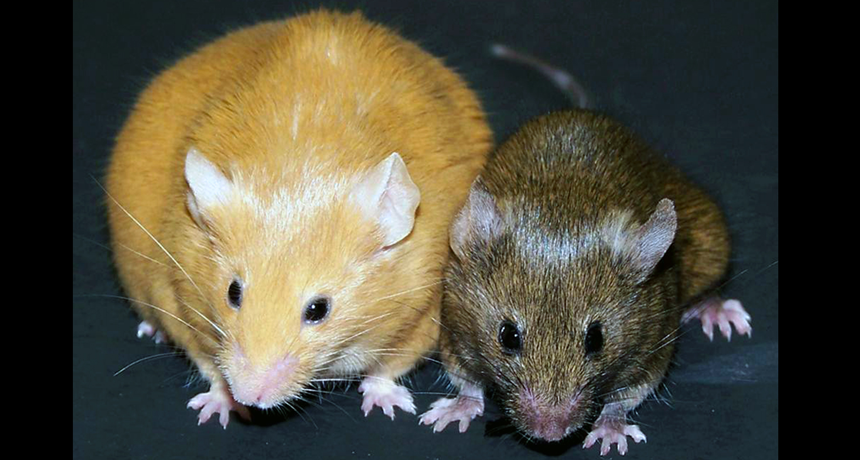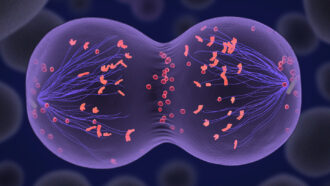Explainer: What is epigenetics?
Sometimes how our cells act is not thanks to what’s in our genes, but what’s on them

These mice should look identical. But the one on the left has a different colored coat and faced a higher risk of obesity. That’s because of an “epigenetic” change to how one of its genes works.
R. Jirtle and D. Dolinoy / Wikimedia (CC-by-3.0)
Share this:
- Share via email (Opens in new window) Email
- Click to share on Facebook (Opens in new window) Facebook
- Click to share on X (Opens in new window) X
- Click to share on Pinterest (Opens in new window) Pinterest
- Click to share on Reddit (Opens in new window) Reddit
- Share to Google Classroom (Opens in new window) Google Classroom
- Click to print (Opens in new window) Print
By Janet Raloff
Each creature inherits genes from its parents. These provide blueprints for how its cells will grow and act. Those blueprints usually say how those cells will act from conception until death. But sometimes the environment we live in can tweak those blueprints. It doesn’t change the genes themselves — so the change is not genetic. Instead, the environment changes certain molecules that act a bit like light switches. They don’t illuminate or darken a room. These switches instead turn a gene on or off.
Such changes are described as epigenetic. The term means “above the genes.”
The switches are often molecules called methyl groups. (This refers to a carbon atom stuck tightly to three hydrogen atoms. Their formula is written CH3.)
Around the time a mammal is born, those switches attach to its DNA. They glom onto the DNA next to certain genes. A child’s epigenome, or full set of switches, tends to match that of his or her parents when they had been born.
But those switches can change throughout life. Certain factors in the environment, such as pollutants or diet, can damage a methyl group or strip it off of the DNA. In some cases, this will alter how a gene performs. The change may stop a gene from working. Or it might make it stay switched on for too long, or not long enough. Depending on when this improper switching occurs and which gene it affects, the change may have little impact on an animal’s health — or a lot.
The classic example came out of a 2003 experiment by Randy Jirtle and Dana Dolinoy. Both scientists were working at Duke University in Durham, N.C., at the time. They fed some pregnant mice a diet that affected a gene called agouti in their developing pups. This gene controls fur color. Switching it off turned the normally brown mouse pups a golden hue. More importantly, it made them uncontrollably hungry. So they ate and ate and ate. And that made them fatter and fatter and fatter.
The young mice looked and acted different because their mothers’ diets had caused epigenomic (EP-ee-jeh-NO-mik) changes to their DNA. Those changes happened while the babies were growing in the womb. But these fat, golden animals would not pass on those changes to their own young. That’s because a fetus has a way to erase epigenetic changes from the DNA it inherits. It starts with a clean slate, then puts on some methyl groups, but only where its normal genetic inheritance says they belong.
Or so scientists had thought.
Seven years after the Duke study, Margaret Morris and her team showed that environmental changes to the epigenome also could be inherited. Morris worked at the University of New South Wales in Sydney, Australia. The researchers took healthy male baby mice and raised half on a normal diet. The rest ate high-fat food. They downed an unhealthy number of calories, grew fat, and eventually developed diabetes. It’s the same pattern seen in many people.
When these now-fat males mated with slim females, the resulting babies grew into tubby mice. But when the slim males mated with slim females, the babies grew into normal-size mice. This was evidence that the overweight, diabetic dads had epigenetic changes to their DNA, and could pass down those changes to their children.
A few years later, Michael Skinner and his colleagues at Washington State University in Pullman did a similar study with pollutants instead of diet. They showed that when dads were exposed to certain pollutants, they could pass on epigenetic changes — even to their grandchildren.
A pollutant’s epigenetic effects shouldn’t show up in subsequent generations, John McCarrey told Science News at the time. He’s an epigeneticist who worked at the University of Texas at San Antonio and was not involved in the study. But in the Skinner study, these changes did show up in later generations. And that, he said, “is pretty heavy in terms of their potential significance.”
Since then, a host of other studies also have shown that some epigenetic changes may be passed down from a parent to its offspring — and beyond.







